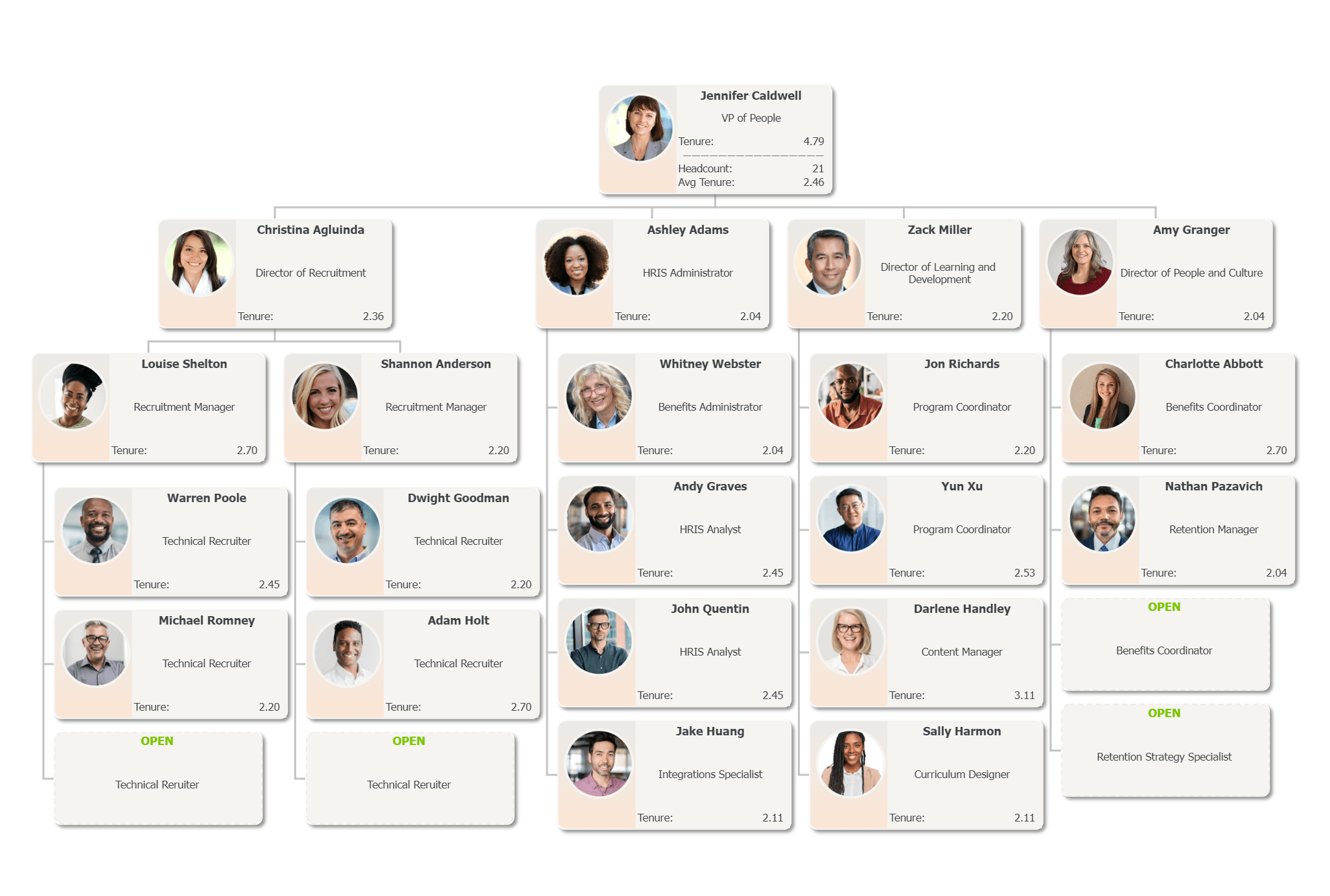May 1, 2024
8:37 AM
By OrgChart Team

In modern workplaces, understanding and managing employees across each stage of their journey is critical. This journey, known as the employee life cycle, encompasses seven stages employees go through, from attraction to offboarding. Each stage plays an essential role in shaping employees’ experiences and enhancing organizational outcomes. Read on to further explore this lifecycle framework and glean insights into how to navigate each stage for a happy, engaged, and productive workforce journey.
An employee life cycle is the journey an employee takes within an organization. This life cycle tracks employee progression through each stage from attraction to separation. Each stage plays an integral part in shaping their journey and supporting the organization’s operations. From the moment they show an interest in an organization through their growth within the company and their eventual departure, each individual is at a different stage in their unique journey. The employee life cycle is essential for understanding and managing an employee’s experiences. Organizations can use this knowledge to create and maintain a supportive, fulfilling workplace that attracts, retains, and nurtures top talent.
The employee life cycle encompasses seven key stages:
The employee life cycle model is a structured framework for understanding each step an individual takes within the organization across seven key stages. This framework serves as a roadmap for managing the various stages, encompassing key touchpoints and interactions that affect both the employee’s experience and the company’s measures of success. This model serves as a strategic tool for human resource professionals to align HR practices with organizational goals.
Organizations can implement the employee life cycle model by creating a structured approach to talent management that aligns with the stages of this life cycle. HR leaders should develop standardized processes and leverage technology to streamline workflows and communication for increased engagement, retention, and performance.
Every employee’s experience in an organization is valuable. As such, effectively managing the employee life cycle will impact organizational success. A comprehensive understanding of an employee’s feelings and experiences during each stage of their journey allows human resource professionals and organizational leaders to make informed decisions about their most important assets–their employees. When employees feel valued, supported, and engaged at each step in their journey, they are more likely to put their best foot forward to achieve organizational objectives. Ultimately, a satisfied workforce gives organizations a competitive edge, driving successful organizational performance, employee engagement, and retention of top talent.
Employee life cycle management also helps organizations align human resource practices with organizational goals. By integrating HR strategies with broader organizational goals, organizations can ensure their talent management efforts are consistently contributing to key performance indicators (KPIs) and organizational outcomes.

The first stage in the employee life cycle is attraction. This stage involves capturing the interest of potential talent. In this stage, individuals don’t engage directly with the organization. Instead, they hear about the company or role through a job posting, advertisement, word of mouth, or other means. This stage is critical to master. Based on a potential candidate’s insights during the attraction phase, they will decide whether or not to apply with an organization. Attracting top talent affects every subsequent step in the employee life cycle process.
Strategies for success in the attraction stage:
The second stage, recruitment, involves interviewing and selecting talent who best fits the position and organization’s needs. Organizations that ensure a positive experience during this stage are more likely to have potential candidates choose to move forward with the role once selected. Recognizing that an interview is reciprocal is essential to success in this stage. While HR leaders interview potential candidates to find the right fit for their organization, the candidates also interview the company to ensure it’s the right fit for their needs and aspirations.
Successful recruitment requires a deep understanding of the types of individuals your organization needs. Tailor job postings, application processes, and interview strategies to match these needs.
Strategies for success in the recruitment stage:
The next stage is onboarding. During this stage, you integrate the new employee into your organization and familiarize them with their new role and workplace. You also focus on establishing a relationship with your new hire, building rapport, and setting the foundation for success.
Strategies for success in the onboarding stage:
As your new employee has had time to adjust to their role and pass the onboarding stage, they enter the engagement stage. During this time, your focus is on fostering a positive work environment, further building rapport, and promoting job satisfaction.
Strategies for success in the engagement stage:
The fifth stage, development, focuses on nurturing your employee’s skills and knowledge. Job development occurs through training, coaching, and career development plans. With burnout on the rise in many industries, job crafting is one potential way to reduce the likelihood of burnout and increase job satisfaction (Martinez-Diaz et al., 2023). In a 2021 research survey on why employees left their company, a startling 63% reported a lack of opportunities for advancement.
Strategies for success in the development stage:
It’s important to avoid getting too comfortable with the status quo. This is why the retention stage is critical to plan for effectively. Sometimes, leaders tend to spend less time on staff in the retention phase and focus more on ramping up new staff in the early stages of the employee life cycle. Maintaining employee satisfaction and positive work throughout the retention phase is vital.
Strategies for success in the retention stage:
The last stage in the employee life cycle is offboarding, which occurs when an employee transitions out of the organization. While the organization may face challenges, like scrambling to replace and retrain a new staff member for the role, it’s important to maintain professionalism, respect, and support during this time.
Strategies for success in the offboarding stage:
Key Performance Indicators (KPIs) are crucial in evaluating the effectiveness of the employee life cycle stages and identifying areas needing improvement. KPIs should be analyzed on an ongoing basis to make data-informed decisions that enhance the employee experience and organizational success.
Some of the most important KPIs to track and measure through the life cycle include:
In today’s digital world, technology, such as HR software and analytics tools, is pivotal in enhancing the employee life cycle. Automated workflows for onboarding, performance evaluations, and other tasks across each stage reduce manual effort and minimize errors or oversights, ultimately improving efficiency.
Data-driven insights are invaluable for making informed decisions in all industries. Technology allows HR leaders to track and analyze data across every stage, from attraction to offboarding. HR analytic tools help organizations identify trends, forecast challenges and areas of opportunity, and ensure continued job satisfaction.
Employee engagement is vital for retaining top talent and ensuring a positive work experience. Technology provides HR professionals with the tools to improve communication and collaboration throughout the life cycle, ensuring continual engagement.
Incorporating technology into every stage of the employment life cycle enhances efficiency and data-driven decision-making and improves employee engagement and job satisfaction.
References
Martínez-Díaz, A., Díaz-Fúnez, P. A., Salvador-Ferrer, C. M., Hernández-Sánchez, B. R., Sánchez-García, J. C., & Mañas-Rodríguez, M. Á. (2023). Mediating effect of job crafting dimensions on influence of burnout at self-efficacy and performance: revisiting health-impairment process of JD-R theory in public administration. Frontiers in psychology, 14, 1137012. https://doi.org/10.3389/fpsyg.2023.1137012